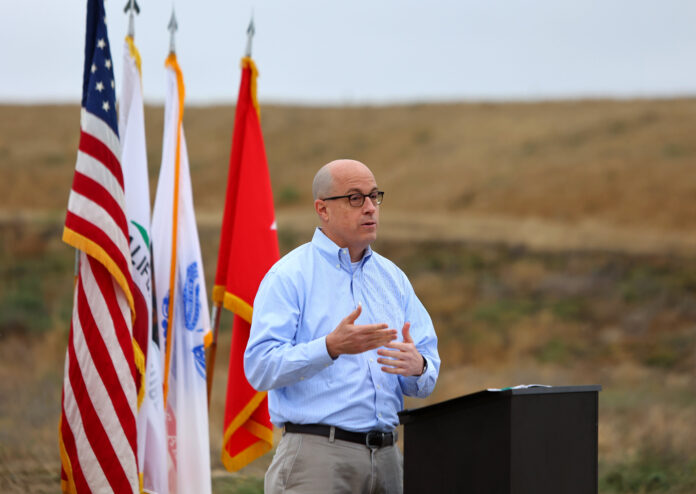
High-ranking Pentagon officials gathered along with local military officials at the Joint Forces Training Base in Los Alamitos this past week to break ground on a sustainable energy project making JFTB the first U.S. Army installation in the nation to build its own microgrid.
Bright Canyon Energy, a solar company, will construct, own and operate the energy resilience project with high-performing solar panels on approximately 100 acres of the massive facility’s approximately 1400 total acres, military officials have announced.
“Thank you to the Secretary of the Army and the army office of energy initiatives for selecting JFTB for this project,” said Lt. Col. Manju VIg, the base Commander, “and our sincerest appreciation to all our partners and teammates,” she said.
“We are honored to serve as California National Guard’s major installation in Southern California and home of one of the only military airfield in Orange and Los Angeles counties,” she said. “The energy resilient microgrid project that we break ground for today marks a landmark moment for installation and the surrounding region,” said Lt. Col Vig.

“This is very critical and important to us,” said Major General Michael Leeney, a former base Commander who has now assumed command of the 40th Infantry Division. Leeney said the project began nearly a decade ago, in 2014, when he was asked to represent the base as preliminary discussions began.
“I’m about to help put a shovel with dirt on this project,” said Leeney. “Energy resilience is something that we as a state have been actively pursuing, just like the Department of the Army. This project only reinforces the commitment that we’ve had in that regard to move forward.”
He said the new microgrid will assist the base in providing secure operational capability.
“This is also going to provide a substantial source of power for the local communities which we think is very important,” he added.
“I am thrilled around this project,” said Pentagon-based Paul Farnan, Principal Deputy, Assistant Secretary of Army for Installations, Energy and Environment. He said the Bright Energy project is a self-contained, clean energy storage and microgrid that “really hits the two big things that I spent a considerable amount of time focusing on, the Army’s climate strategy and self-reliance.”
“Back in February, we published the army climate strategy. We are the first military service to publish such a strategy. I’m very proud to say we are also currently, the only service to have done so.”
Farnan said the Army is “absolutely leading the way in this to have clean solar power with battery storage that embodies everything that we’re looking for in our climate strategy.”
“The other half that I really spend a lot of time focusing on, which is directly related because the climate strategy feeds into it, is the resilience of our installations. We are in a world where we have to operate no matter what is happening outside of our fence line,” he said.
Farnan said JFTB is “a perfect example of the hub for emergency operations in Southern California. If something happens, we [U.S. Army, California National Guard and U.S. Army Reserve] need to be able to operate, no matter what happens to the grid outside the base.”
“Whether it’s an accident, whether it’s an earthquake, some other wildfire, natural disaster or whether it’s a manmade cyberattack, the grid goes down we absolutely need to be able to operate to support the local community,” he said.
“We are leading the way for the federal government. And with this project in Los Alamitos, this installation is leading the Army, so thank you very much.”
Robert “Bob” Smith, President Bright Canyon Energy, said his company was proud to be part of the U.S. Army’s first microgrid installation.
“When we talk about this project, and about microgrids in general, we use words like resilience, security, power, reliability. You’ve heard those words already,” said Smith.
“But as I stand here, I think of something else associated with those same words. And that’s the brave men and women of our military and so many of you in attendance today.
And that’s what makes this partnership a great fit,” he added.
He said the project’s 100 acres of solar panels will generate approximately 26 megawatts (MW) of solar energy, it includes a 20/40 MW battery for storage and 3 MWs of backup generation. “For perspective, one megawatt is enough to power about 200 homes,” said Smith.
“So this is a pretty large facility that we’re putting in for you,” he added.
“Our mission at Bright Canyon is to grow sustainable energy solutions,” said Smith, “and through this Energy Resilience Project, our missions come together and it’s our honor to assist you in carrying out your mission to serve the American people and protect our nation’s vital interest.”
He said the base’s microgrid control system will enhance installation energy reliance by providing power for full critical JFTB missions for a minimum of 14 days during electrical grid outages, said Smith.
During normal operations, the power generated will be sold to San Diego Gas & Electric using Southern California Edison’s transmission system. During emergencies, the agreement allows for the base to utilize all of the power generated and what is available in storage, said Smith.
“This is great work and would not be possible without the support from so many partners,” he said.
“First and foremost the US Army, the Assistant Secretary of the Army for Installations Energy and Environment, the Army Office of Energy Initiatives, the California National Guard, the US Army Corps of Engineers, and, of course, the Joint Forces Training Base in Los Alamitos.
“Thank you for your vision and commitment to arrive at this important groundbreaking milestone today.”
While the JFTB microgrid in Los Alamitos is the first such installation in the nation, Farnan said the U.S. Army is on track to have a microgrid in every installation by 2035.
Officials say the JFTB microgrid is expected to be generating solar power by this time next year.
